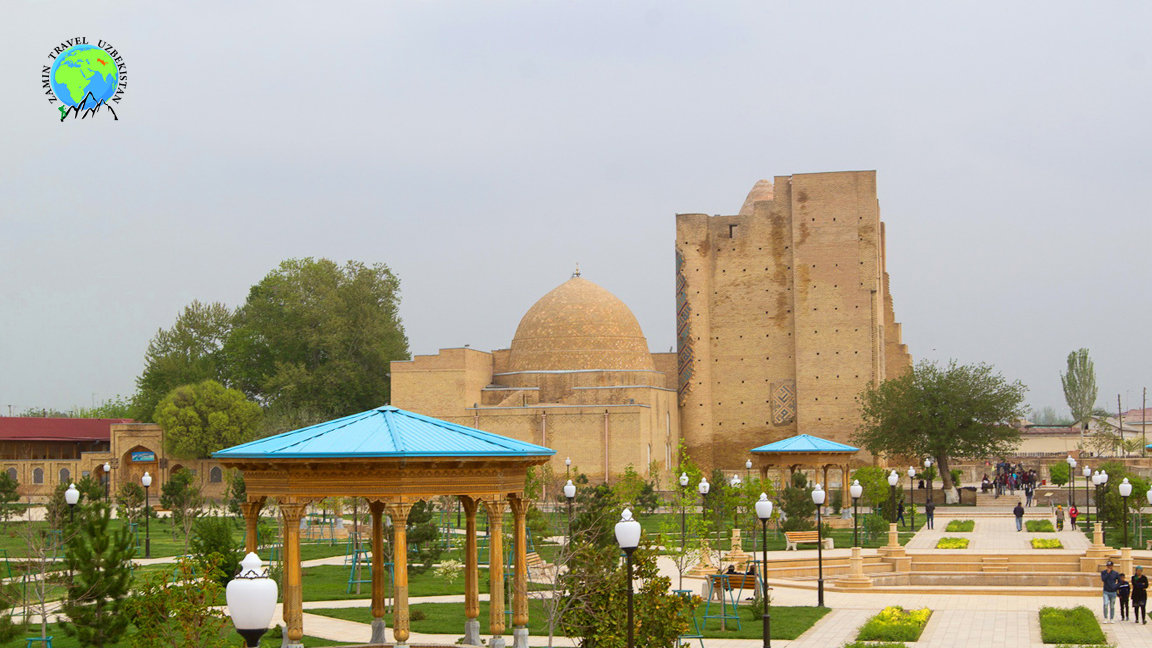


Along with the construction of the Ak-Saray Palace in 1380, the Dorussiadat complex was also started. Only two buildings of this complex have survived to this day. The Djahangir mausoleum and the crypt for Timur, in which the great prince and conqueror was never buried, have been preserved. A gloomy premonition motivated Timur to start building the memorial. In 1376 Timur intended to have his eldest son Djahangir, whom the ruler loved very much, as his sole successor. Suddenly Djahangir died at the young age of 22. The residents of Samarkand mourned the loss of the Crown Prince - as a "fair prince, a brave warrior who flashed the earth like a rose". The death of his beloved son became an overwhelming grief for the ruler Timur. The young prince Djahangir, who died in Samarkand, was brought to the hometown of his ancestors in Shahrisabz, where he was buried in the family cemetery in the old city area has been. It seems that Timur had an idea to build a mausoleum for himself and his descendants. It was not until four years later, after his military campaign against Khorezm was completed, that construction of the tomb in Shahrisabz began. A mausoleum was built over the tomb of the crown prince, with an adjoining madrasah, which became a philosophical and spiritual center of the complex. The name of the complex itself "Dorussiadat" can be interpreted in Arabic as the "seat of power". The madrasah has not survived. According to the Arab historian Malikho, the madrasah was destroyed on the orders of Abdulla Khan in the 17th century with the “command of power”. During the excavation work in the area of the Dorussiadat complex, it was discovered that the Djahangir mausoleum adjoined the room of remembrance to the east. In the south of the mausoleum, a portal niche of the madrasah with an arch span of more than 20 meters was discovered. A passage led through the portal to the inner courtyard of the madrasah with remains of the column walls. The stone slabs and contours of the niches and portals have only been partially preserved to this day. The Dorussiadat madrasah was originally not intended for teaching, but for carrying out religious remembrance rituals. Preserved documents of the Madrasah contain records of estates, mansions, and gardens. This property was intended for the maintenance of the dynasty and for the burial of his descendants. After Ruy Gonzáles de Clavijo, the ambassadors of the King of Castile were brought to the court of Amir Timur to admire the madrasah and the mausoleum of Djahangir, which was richly decorated with azure blue tiles. There was also a garden with a swimming pool. In 1394, Umar Shekh, the second 29-year-old son of Timur, died during the siege of Kurds in Iran. His body was taken to Shahrisabz and buried in the Dorussiadat complex. Every day, through special rituals, the Timurid was brought the meat of 20 cooked sheep to the madrasah in memory of his sons who are buried in the complex. Although Timur had ordered it, the construction of his mausoleum remained unfinished. In 1404 he checked the construction and was rather dissatisfied with the results. He found the entrance too low and had it torn down and ordered it to be rebuilt. This mausoleum has unfortunately not survived the last few centuries. However, on the basis of historical documents, as well as the results of archaeological research, the Timur crypt was found on the territory of the Dorussiadat complex. This is one of the most remarkable buildings of the Amir Timur era. Based on the records of his contemporaries, the radiant, lush decoration of the building above ground is juxtaposed with the unpretentious furnishings of the underground crypt. The steep staircase on the southern side of the mausoleum can be found in a small room with about 131 square meters. The walls, floors and ceilings with the support of arched arches are made of slabs of light gray marble-limestone. In the middle of the room in the floor there is a marble sarcophagus. It is covered with a large, monolithic marble tombstone, which is approx. 11 cm thick, with five iron rings at the corners and in the middle. On the marble tombstone it says: "The command belongs to Allah alone". On the walls, arches, rings and medallions are carved in Sulu script quotes from the Koran and inscriptions. “He is eternal, and in God's hand all is good, above all things. He has power. ”Fate would have it that the body of Amir Timur was not buried in the crypt of Shahrisabz, but in the Gur-Emir mausoleum in Samarkand, the capital of Timur, known in the west as Tamerlane.